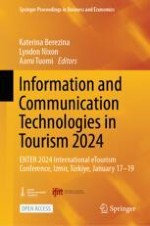1 Introduction
-
We propose a travel planning system which integrates spot information based on user generated contents, POI recommendation and route suggestion.
-
To address cold-start user scenarios, in Sect. 3.3, we introduce novel photo-based information acquisition methods, which are more user-friendly compared to existing approaches.
-
To address the issue of overtourism, in Sect. 3.5, we utilize a variety of congestion-aware methods for route recommendations. Users can select routes with varying levels of congestion consideration based on their preferences.
-
To evaluate the proposed U-KyotoTrip, we conducted an empirical user study. The results of the user study demonstrate that users are satisfied with U-KyotoTrip, the recommended spots and the approach that utilizes photos to present preferences.
2 Related Work
3 System Overview
3.1 System Architecture
3.2 Information Display Module
3.3 Preference Capture Module
-
The new user can review spot information and mark certain spots as either “want to visit” or “do not want to visit”.
-
The new user is asked to rate several photos provided from the server. Based on the ratings of the photos, the user’s preferences are inferred.
-
Alternatively, the new user can upload photos to the server. Descriptive words for these photos are extracted using the scene detection method proposed by [19]. These extracted words are considered as keywords representing the user’s preferences, which are then used to infer their preferences.
3.4 POI Recommendation Module
3.5 Route Recommendation Module
-
MARLRR: An multi-agent reinforcement learning approach proposed in [16] for solving the congestion-aware route recommendation task. This method considers that several groups are moving simultaneously, and a congestion penalty of reward function is introduced to avoid overconcentration at spots.
-
RPMTD: A multi-agent reinforcement learning based route recommendation method proposed in [17] that considers both multiple users accessing simultaneously and the congestion at attractions. This method introduces a dual-congestion mechanism, in which both the local congestion at visited spots and the global distribution of tourists affect tourists’ satisfaction.
-
Non-Dual RPMTD: An alternative version of RPMTD that does not consider the global distribution of tourists in the dual-congestion mechanism.
-
Pointer-NN: A reinforcement learning approach to the Orienteering Problem with Time Windows proposed in [21], without considering congestion.
-
TRGCSC: A reinforcement learning approach proposed in [18], which is based on [21] and introduces two novel concepts, “dynamic stay duration” and “environmental tax metaphor.” The former concept estimates the necessary stay duration at a spot based on its congestion, and the latter concept assigns dynamic rewards depending on congestion at spots.
3.6 Interface and User Interaction
Characteristics | Percent | Percent | ||
|---|---|---|---|---|
Gender | Male | 39.02% | Female | 60.98% |
Frequency of travel | Once every few years | 14.63% | Once a year | 12.20% |
Twice a year | 34.15% | Once every quarter | 34.15% | |
Once every two months | 17.07% | Once a month | 7.32% | |
Twice a month | 12.20% | Once a week | 2.44% | |
Duration of travel | Daytrip | 12.20% | 2 days | 4.88% |
3 days | 19.51% | 4 days | 17.07% | |
5 days | 14.63% | 6 days | 0% | |
7 days | 14.63% | More than 7 days | 17.07% | |
Factors of concern | Price | 78.05% | Time cost | 48.78% |
Scheduling | 63.42% | Season | 56.10% | |
Popularity | 48.78% | Congestion | 80.49% | |
Popular or | Less-known places | 63.42% | Neutral | 7.32% |
less-known spots | Popular places | 29.27% |
4 User Study
4.1 Participants and Setting
-
Q1. How many of the recommended spots did you like?
-
Q2. Did you find the number of recommended spots too many or too few?
-
Q3. Did you find the types of recommended spots too many or too few?
-
Q4. Did you find the popular spots too many or too few?
-
Q5. Did you find less-known spots too many or too few?
-
Q6. How satisfied did you feel overall with U-KyotoTrip?
-
Q7. Did the recommended spots meet your satisfaction?
-
Q8. Did you find the use of photo ratings to express preferences satisfactory?
-
Q9. How satisfied did you feel with the route recommendation methods?
